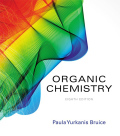
Concept explainers
(a)
Interpretation: The mechanism of the given reactions is to be written.
Concept introduction: The
(b)
Interpretation: The mechanism of the given reactions is to be written.
Concept introduction: The carboxylic acid and its derivatives undergo nucleophilic acyl substitution reaction. The incoming group is called as nucleophile and the substituent that departs from molecule is known as leaving group. If the attacking group is a good base as compared to the substiuent that is already present than attacking group will replace the existing substituent.
Want to see the full answer?
Check out a sample textbook solution
Chapter 15 Solutions
EBK ORGANIC CHEMISTRY
- Triethylamine is utilized as a base in organic synthesis and can form quaternary ammonium salts when alkylated. The structure of triethylamine in shown below:arrow_forwardEsters and amides are most easily made by nucleophilic acyl substitution reactions on… A. alcohols B. acid chlorides C. acid anhydrides D. carboxylates E. carboxylic acidsarrow_forward1. Write the structure of the major organic product formed when nonanoyl chloride is each of the following reagents: A. Aqueous acid (H3O*) B. Ethanol in the presence of triethylamine C. Excess diethylamine (at least 2 equivalents) D. Sodium acetate E. Lithium aluminum hydride in diethyl ether F. (CH3CH2)2CuLi Cou onch of the following reactionsarrow_forward
- Draw and explain the reaction mechanism between: a. ethane and bromine water b. ethene and bromine water c. ethyne and bromine waterarrow_forwardWhat test will allow you to distinguish between: a. benzyl alcohol and cyclohexanolb. benzyl alcohol and phenol c. cyclohexanol and 1-methylcyclohexanol d. o-cresol and anisolee. benzyl alcohol and anisolearrow_forwardWhat compounds are formed from the reaction of benzoyl chloride with the following reagents? a. sodium acetate b. water c. excess dimethylamine d. aqueous HCl e. aqueous NaOH f. cyclohexanol g. excess benzylamine h. 4-chlorophenol i. isopropyl alcohol j. excess aniline k. potassium formatearrow_forward
- Write the mechanism for each of the following reactions: a. the reaction of acetyl chloride with water to form acetic acid b. the reaction of benzoyl chloride with excess methylamine to form N-methylbenzamidearrow_forwardWrite the equations showing the reactions of propanoic acid with: a. ammoniab. methanal c. thionyl chlorided. methanaminearrow_forwardWhen an equimolar mixture of 1-butanamine and 1-bromobutane reacts, which of these products will form? Select one: a. Tetrabutylammonium bromide b. Dibutylamine c. All of these d. Tributylaminearrow_forward
- Using any necessary reagents, show how the following compounds could be prepared using ethylene oxide as one of the reactants: a. CH3CH2CH2CH2OH c. CH3CH2CH2CH2D b. CH3CH2CH2CH2Br d. CH3CH2CH2CH2CH2CH2OHarrow_forwardWhat products are obtained from the reaction of cyclohexene oxide with a. methoxide ion? b. methylamine?arrow_forward18arrow_forward
 Chemistry for Today: General, Organic, and Bioche...ChemistryISBN:9781305960060Author:Spencer L. Seager, Michael R. Slabaugh, Maren S. HansenPublisher:Cengage Learning
Chemistry for Today: General, Organic, and Bioche...ChemistryISBN:9781305960060Author:Spencer L. Seager, Michael R. Slabaugh, Maren S. HansenPublisher:Cengage Learning
